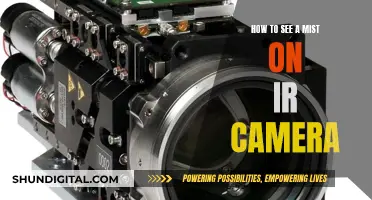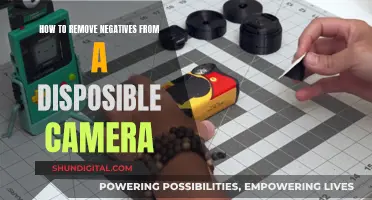
Golf fans have long relied on cameramen to track the golf ball in flight. However, new technology has dramatically changed the viewing experience in watching professional golf tournaments. One of the most notable advancements is the Toptracer (formerly known as Protracer) technology, which uses CMOS sensors in special cameras to follow and track the ball in flight and convert that data into the flight graphics that viewers see on their screens. This technology has revolutionized the way people watch golf, providing real-time shot analytics and enhancing the viewing experience for fans at home.
| Characteristics | Values |
|---|---|
| Technology | Toptracer, CMOS sensors, Hawk-Eye, Radar technology |
| Camera placement | Behind the golfer, towers, trees, blimps |
| Camera movement | Gyroscopes, lightweight cameras |
| Ball tracking | Sensors, computer software |
| Data | Clubhead speed, launch angle, ball spin, ball speed, apex, curve, carry |
What You'll Learn
- Camera operators need to understand the game and predict the ball's trajectory
- Gyro-stabilized cameras are used to smoothly track the ball's flight path
- Tracking cameras use CMOS sensors to identify the ball in each frame
- Toptracer technology can be moved around the course to provide additional graphics and data
- The camera operator's skill and knowledge of the game are still important

Camera operators need to understand the game and predict the ball's trajectory
Camera operators play a crucial role in capturing the action and drama of a golf game, and their understanding of the game and ability to predict the ball's trajectory are key to this process.
Golf is a complex and unpredictable sport, and camera operators need to have a good knowledge of the game to be able to effectively capture the action. They must be able to anticipate where the ball will go and adjust their camera angles and positions accordingly. This requires a deep understanding of the game, the players' skills, and the course conditions.
The camera operators' ability to predict the ball's trajectory is essential for following the action and creating a compelling viewing experience. By understanding the game, they can anticipate the ball's flight path, the players' strategies, and the potential outcomes of each shot. This predictive ability allows them to position themselves optimally, track the ball effectively, and capture the critical moments of the game.
Additionally, camera operators must also react to the unpredictable nature of the game. Even with their knowledge and experience, there are times when a shot may go awry or a player may make an unexpected move. In such situations, the operators need to be quick-thinking and agile, adjusting their camera angles and positions on the fly to ensure they don't miss a crucial moment.
Over the years, advancements in camera technology have also played a significant role in improving the viewing experience of golf tournaments. Lighter and more manoeuvrable camera systems, along with the development of gyro-stabilized cameras, have made it easier for operators to track the ball's trajectory and follow golfers through their rounds.
However, despite these technological advancements, the role of the camera operator remains vital. Their skill, experience, and understanding of the game are indispensable in capturing the drama, tension, and excitement of golf, contributing to an engaging and immersive viewing experience for audiences.
Is My Camera Watching Me?
You may want to see also

Gyro-stabilized cameras are used to smoothly track the ball's flight path
The use of gyro-stabilized cameras has revolutionized the way golf is broadcast on television, allowing for smooth tracking of the ball's flight path and providing viewers with an immersive viewing experience. These specialized cameras employ gyroscopic stabilization technology to maintain stability and precise control during rapid movements, enabling camera operators to effortlessly follow the golf ball's trajectory.
Gyro-stabilized systems offer a highly stable platform for broadcasting live sports events, including golf tournaments. The gyroscopic stabilization technology counteracts unwanted motion and external forces, such as wind, air turbulence, or vehicle movement, ensuring that the camera remains steady and focused on the subject. This technology is particularly advantageous in dynamic and challenging conditions, where maintaining a stable camera position would otherwise be difficult.
By employing gyro-stabilized cameras, camera operators can capture smooth and seamless footage of the golf ball's flight path. These cameras can quickly move and adjust to track the ball's trajectory, providing viewers with a clear and uninterrupted view of the action. The stabilization technology helps resist movement in pitch, yaw, and roll, resulting in stable and shake-free visuals.
The impact of gyro-stabilized cameras extends beyond just tracking the ball's flight path. Their lightweight and maneuverable design allows camera crews to easily follow groups of golfers throughout their round. This capability enhances the overall broadcast by providing comprehensive coverage of the tournament, capturing not only the ball's flight but also the players' movements and reactions.
In addition to gyro-stabilization, advancements in ball-tracking technology, such as Toptracer (previously known as Protracer), have further enhanced the viewing experience. Toptracer utilizes CMOS sensors in special cameras to follow and track the ball's flight, converting the captured data into real-time graphics that viewers see on their screens. This combination of gyro-stabilization and advanced tracking technology has transformed how golf is presented and perceived by audiences worldwide.
Accessing Yi Camera Footage on PC: A Step-by-Step Guide
You may want to see also

Tracking cameras use CMOS sensors to identify the ball in each frame
CMOS sensors are the same as those found in modern DSLR cameras. They are linked to a computer, which identifies the ball in each image and creates a real-time tracking image of the flight path, delivering it to TV screens.
CMOS sensors were conceived in the 1960s but were not commercialised until the 1990s when microfabrication technologies became advanced enough. They are now the dominant sensor type, surpassing CCD sensors from 2004 onwards in shipment volume. This is due to various improvements, such as faster data rates, lower costs, and energy efficiency.
CMOS sensors are particularly useful for tracking fast-moving objects like a golf ball as they can amplify pixel signals directly and sequentially, and at a much higher speed than a CCD sensor.
Smart TV Spy Cameras: Fact or Fiction?
You may want to see also

Toptracer technology can be moved around the course to provide additional graphics and data
Toptracer is the leading golf range technology, offering more games, insights, and play than any other. The technology uses CMOS image sensors to capture a golf ball in flight and extrapolate its exact flight. CMOS stands for complementary metal-oxide-semiconductor, and the sensors use a photodiode and CMOS transistor switch for each pixel. Light enters the micro-lenses, passes through red, green, and blue colour filters, and through photodiodes to produce an electrical signal output.
Toptracer has been continually developed since its launch, with new features added to enhance the viewing experience. These include clubhead speed, launch angle, and ball spin, all of which are now seen on TV during major golf tournaments. The technology has also been adapted for use at Topgolf facilities and golf ranges, allowing golfers to analyse their swing and ball stats.
Setting Up Swann Camera System: A Step-by-Step Guide
You may want to see also

The camera operator's skill and knowledge of the game are still important
Camera operators need a good understanding of the game to predict the trajectory of the ball and adjust their camera angles and positions accordingly. This knowledge, combined with their skill and quick reflexes, enables them to follow the ball and capture the critical moments of the game. Even with the latest technology, it is still a challenging task to track a small white ball against varying sky conditions, and this is where the camera operator's expertise comes into play.
The placement of the camera is also essential. The camera is typically positioned behind the golfer to capture the optimum data, but it can be moved to different locations on the course to provide a variety of graphics and data for viewers, players, and commentators. The skill of the camera operator is particularly evident when following "lead groups" of golfers through their round. Their ability to walk with the golfers and capture the action seamlessly adds to the viewing experience.
Additionally, the camera operators' intuitive understanding of the game and its nuances helps create tension and excitement in the broadcast. They know where to point the camera to capture the most compelling shots and how to use different camera angles and techniques to enhance the storytelling aspect of the broadcast. This human element brings a unique perspective to the viewing experience that pure technology cannot replicate.
While technology has undoubtedly enhanced golf broadcasting, the role of the camera operator remains vital. Their skill, knowledge, and ability to react intuitively ensure that viewers at home can enjoy a dynamic and engaging presentation of the game.
Actors' Aversion: Watching Themselves on Camera
You may want to see also
Frequently asked questions
TV cameras show the arc of a golf ball using a technology called Toptracer, which was originally called Protracer until it was rebranded in 2016. Toptracer uses CMOS sensors in special cameras that follow and track the ball in flight and convert that data into the flight graphics that you see on your TV.
Toptracer uses CMOS sensors (CMOS stands for Complementary Metal-Oxide Semiconductor), the same ones found in modern DSLR cameras, to create 3D space. When the golf ball travels through that space, the sensors track it in real time. The CMOS sensors are linked to a computer, which identifies the ball in each image and creates a real-time tracking image of the flight path, which is then delivered to the TV screens.
Cameramen need a good knowledge of the game to accurately estimate where the ball will go and direct the camera to catch it. Gyro-stabilized cameras are often used to make it easier to smoothly track the golf ball on its flight path.
It can be challenging for even the most experienced operator to lose sight of a golf ball, especially when it follows an unexpected trajectory. A premium ball is also easy to lose against the sky, regardless of the weather conditions.







